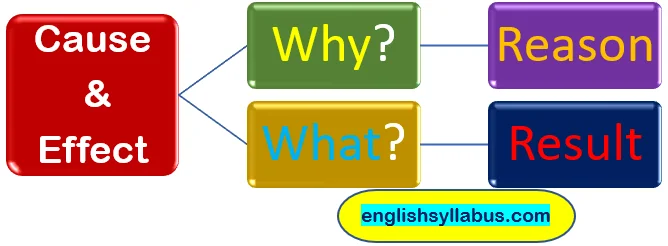Cause and Effect Definition
Cause and Effect mean the relationship between two situations correlated to Why (Reason) and What (Result). The cause gives us the reason why something happened whereas the effect shows us the result of what happened.

Examples of Cause and Effect
- Heavy rain causes flooding.
- Running 🏃 reduces stress.
- Stress is reduced due to running.
- My bike 🚲 got punctured because of a nail.
- Slipping from the stairs has injured her.
- The ice cream melted because the sun was hot.
- Cause: Heavy Rain = Effect: Flooding
- Cause: Running = Effect: Reducing Stress
- Cause: A nail = Effect: Bike punctured
- Cause: Slipping from stairs= Effect: Injury
- Cause: The sun was hot = Effect: Ice cream melted
Conjunctions used in Cause and Effect
| Cause | Effect |
| because of/ as a result of | so |
| since | therefore |
| as | consequently |
| owing to | which is why |
| due to | that’s why |
Transitions or Conjunctions help you when you’re trying to make your flow together more smoothly and coherently in a cause-and-effect paper, writing, speech, or whatever it is.
Here is a list of transitions and connectors for correct writing. So, you can read and look at them to see which ones you’re familiar with it. But pick a cause-and-effect relationship that’s simple to write a sentence for every one of these transitions and connectors just as a practice.
So, we’re going to talk about= running. The following Conjunctions can be used to show the logical relationship.
Cause and Effect Analysis
Running reduces stress.
Running is the cause= “reduces stress”, is the effect. There’s a relationship to apply to every single one of these transitions and connectors.
- Because of
- Because of running, stress can be reduced.
- As a result
- Running can reduce stress as a result.
- As a consequence
- As a consequence of running stress can be reduced.
- Something results in
- Running results in reducing stress.
- Due to
- Reduced stress is due to running.
- Effect of
- Reduced stress is the effect of running.
- The consequence of
- Reduced stress is the consequence of running.
- Affects on
- Running affects stress.
- Since
- Since I started running my stress levels have gone down.
- The first/second/final effect of this is
- The first effect of running is that it reduces stress.
- As a result
- I run every day, and as a result, I have low stress.
- As a consequence
- I run every day, and as a consequence, I have low stress.
- Consequently
- I run every day, consequently, I have low stress.
- Therefore
- I run every day therefore I have low stress.
- Causes
- Running every day causes lower stress levels.
- The effect of
- The effect of running is low stress.
- The reason for
- Running is the reason for lower stress.
Examples
For example, when the sun shines after it rains. A rainbow is a result so the sun shining after the rain causes the result of the rainbow effect.

Now, even though the cause always happens first, it may not be written first. In this example, it is known that the sun and rain happen before the rainbow, the cause, and then the effect. However, when we write, it doesn’t have to be in the same order we could write. But we see a rainbow because the sun came out after the rain.
In English, authors use many keywords to show this relationship. For Example:
- The ice cream melted because the sun was hot.
- The ice cream melted since the sun was so hot.
In these two examples, the effect was written first which is =the ice cream melting. But, because of two keywords like =because and since I was able to show the cause which is the sun being very hot.
We could also say:
- The sun was so hot therefore the ice cream melted. Or
- The sun was so hot and as a result, the ice cream melted.
Now, in these two examples, we wrote the cause first which is the sun is so hot. However, we used two different keywords to show the effect. (Therefore, as a result). These are the signal words that we use to show their relationship.
Cause and Effect Method of Development
The cause-and-effect method of development is frequently used to explain why something happened or why you think something would happen. The relationship between a situation and either its cause or its effect should be convincing and practical. Because it is the goal of the cause-and-effect approach to development. The data you have collected should back up the conclusions you draw about the relationships. Like all other techniques, this one is commonly combined with others. For example, a problem with several causes integrates the cause-and-effect approach with the order of importance.
Evaluating Evidence
You should keep in mind the following guidelines since not all of the evidence you gather will be equally valuable:
Your actions and justifications must be relevant to your subject. Avoid making snap judgments that your evidence does not support or point you toward. You may have searched for statistics showing, for example, that more Americans have light-aircraft pilot’s licenses. The statistics do not support the claim that new car sales have decreased in the US, thus you cannot draw that conclusion from them. Your justification must be adequate. Incomplete evidence can lead to false conclusions.
- Driving instruction does not help to avoid auto accidents. There have been crashes involving two of the test-takers.
- Would need more than one study to fully examine the effectiveness of driver-training programs in reducing the accident rate.
- It would be necessary to compare the driving histories of a representative sample of both trained and untrained drivers in a methodical manner.
Conclusion
You should use relevant evidence. If you run a poll to gather your evidence, make sure you get responses from a varied population rather than just people or groups whose opinions are the same as yours. And, your proof must be verifiable. It is possible or unlikely that two occurrences that take place near together in time or space are causally connected. For instance, the fact that an accident happened the day after new traffic signs were installed at a crosswalk does not imply that the signs were to blame. With relevant information and reasoning, you must show how the two occurrences are related.

